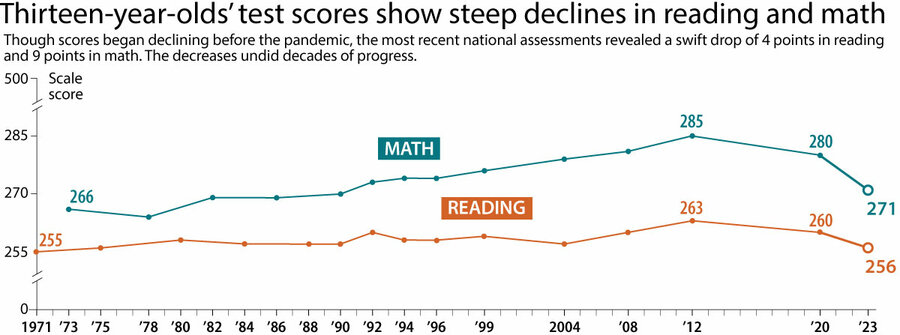Test results reveal falling teen scores. What’s the solution?
Loading...
More incoming U.S. high school students have weaker math and reading skills than previous generations, underscoring the lingering academic challenges following them since the pandemic.
The insight comes from a national sampling of 13-year-olds who participated in a test to gauge reading comprehension and math knowledge during the 2022-2023 school year. The National Assessment of Educational Progress found that students’ average scores fell by 4 points in reading and 9 points in math – a record decline for that subject – compared with teens tested during the 2019-2020 school year.
Why We Wrote This
National test scores are helping focus pandemic recovery in U.S. schools. The release of more data about 13-year-olds suggests solutions are needed for reading – and especially math.
The deep declines offer the latest evidence that academic recovery in the wake of COVID-19-related school closures is slow-moving, putting students on a wobbly path as they enter more difficult courses in upper grades.
To help with progress, more resources – and evidence-based practices – should be directed to “places where students have been long underserved,” says Allison Socol, a vice president at The Education Trust.
“While I’m really glad that this data exists and can shine a light on the reality that faces us,” she says, “it is very important that we shift quickly from ‘What do the data say?’ to ‘What do we do?’”
More soon-to-be high school students have weaker math and reading skills than previous generations, underscoring the lingering academic challenges following them since the pandemic.
The insight comes from a national sampling of 13-year-olds who participated in a test to gauge reading comprehension and math knowledge during the 2022-2023 school year. The National Assessment of Educational Progress (NAEP) found that students’ average scores fell by 4 points in reading and 9 points in math – a record decline for that subject – compared with teens tested during the 2019-2020 school year.
The steep declines offer the latest evidence that academic recovery in the wake of pandemic school closures is slow-moving, putting students on a wobbly path as they enter more difficult courses in upper grades.
Why We Wrote This
National test scores are helping focus pandemic recovery in U.S. schools. The release of more data about 13-year-olds suggests solutions are needed for reading – and especially math.
The results from grade-based tests given last year also showed lower reading and math proficiency rates among fourth graders and eighth graders. Separately, eighth graders’ U.S. history and civics knowledge slipped since the pandemic as well.
Martin West, a member of the National Assessment Governing Board, spoke bluntly about the latest test results during an announcement event last week in Maryland. Dr. West, a professor at Harvard Graduate School of Education, said 13-year-olds’ academic declines elicit “additional cause for concern – even for alarm.”
What’s special about this test?
The National Center for Education Statistics administers the assessments, which have come to be known as the “nation’s report card.”
These results stem from the long-term trend assessment – which is age-based and designed to monitor students’ academic performance over time. The first reading assessment of 13-year-olds occurred in 1971, followed by the math assessment of students that same age in 1973.
The test mostly consists of multiple-choice questions that students answer after reading short passages or applying basic math computations or formulas. About 8,700 students – from seventh and eighth grade – nationwide were tested in each subject from October to December.
What’s significant about the results?
The 13-year-olds’ test results mark a downward trend that began before the pandemic. But the declines were widespread, cutting across most student groups, and were the steepest drop ever recorded for math.
Put into context: Students’ average math score this year dropped to its lowest number since 1990, while the average reading score mirrored a level not seen since 1975.
The NAEP assessments also look at how teens in various percentiles perform, and the conclusion this year painted a grim portrait. Students considered lower, middle, and higher performers all saw their math and reading skills dip since 2020, though sharper decreases were recorded among the lowest-performing students.
Additionally, students of all races and ethnicities – except Asian – posted declines since 2020, as did students from different regions and socioeconomic circumstances. But the results show exacerbated achievement gaps between student groups. Black students, for instance, trailed white students by 27 points on the reading assessment and 42 points on the math assessment.
A factor driving the downward trajectory could be tied to how students spend their recreational time. Only 14% of 13-year-olds reported reading for fun almost every day, down from 17% in 2020 and 27% in 2012.
“While I’m really glad that this data exists and can shine a light on the reality that faces us, it is very important that we shift quickly from ‘What do the data say?’ to ‘What do we do?’” says Allison Socol, vice president for P-12 policy, practice, and research at The Education Trust.
What can be done moving forward?
Given the disparities that exist for students of color or those performing at lower levels, Dr. Socol says more resources – and evidence-based practices – should be directed to “places where students have been long underserved.”
She points toward equitable school funding, higher-quality instructional materials, rigorous courses, and curriculum that reflects the identity of students as examples. Tutoring can be an effective tool as well, Dr. Socol adds, because it provides students with strategic academic support and perhaps gives them another trusted adult in their lives.
Students who were convened on a panel to discuss the results, however, made one thing loud and clear: They don’t want mandatory longer school days.
Thiago Hardy, a sophomore at Oakdale High School in Ijamsville, Maryland, says extra hours would only make “mental health and that kind of thing for kids worse.”
Rather than add more time, Amanda Portner, a middle school literacy specialist in Thurmont, Maryland, says the education system needs to look at the efficient use of instructional time.
“There is a significant amount of instructional time that is lost to eight, 12, 14 days of standardized testing,” she says. “And that’s something that we’re all measured by. We all live in that culture. We all live in that world, but we need to be truthful about the time that it’s consuming.”
Pedro Noguera, dean of the Rossier School of Education at the University of Southern California, says for too long the nation has focused on student achievement at the expense of learning and motivation.
“They’re not the same,” he says. “Learning is the path to achievement. We focus on the outcome. ... But the means to improve the outcomes is by getting kids more engaged, more motivated, and we have not done that.”
Fostering in students a love for reading and exploring their own interests, he says, could work wonders outside traditional strategies such as tutoring and summer school.
“Those can be quite helpful,” Mr. Noguera says. “But there’s also a lot students can do themselves to further their education, and we should really focus on that as well.”









